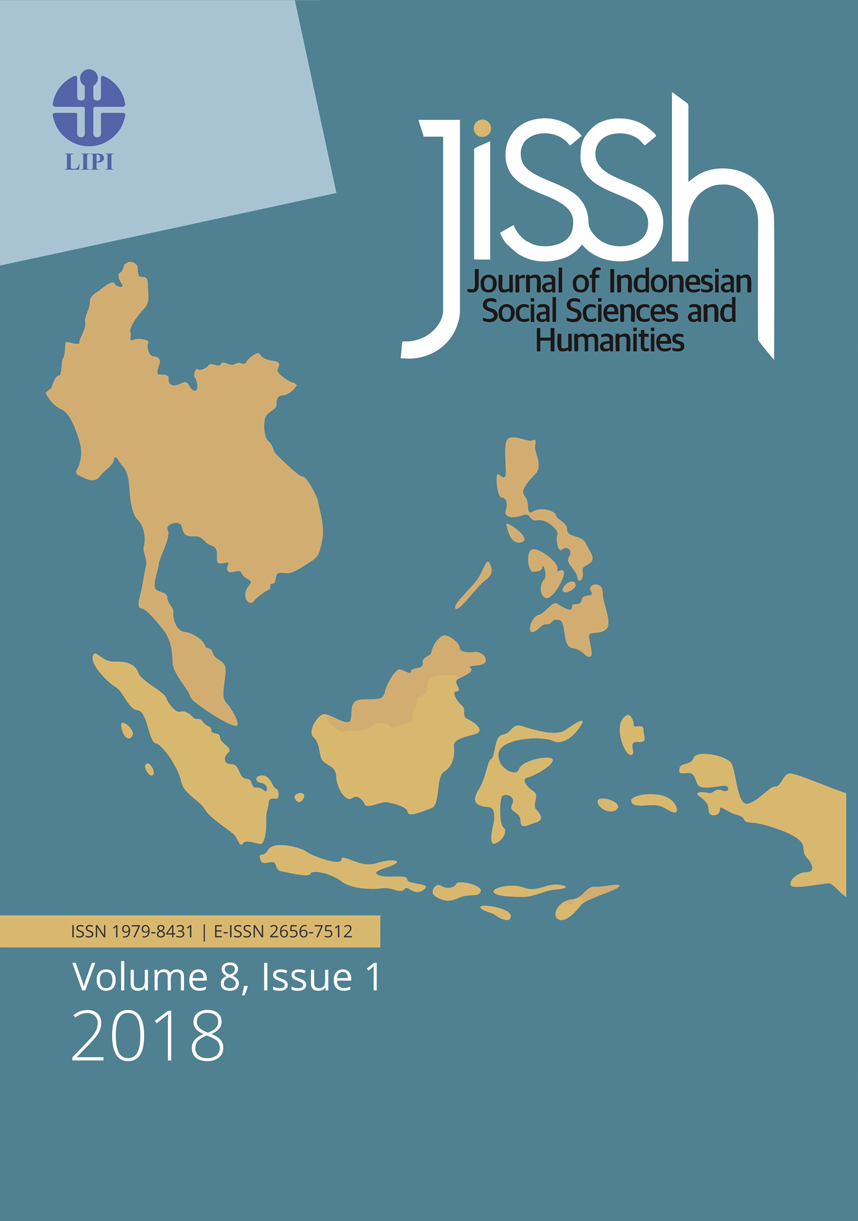Trade Globalization and Its Impact on Welfare in Indonesia
Keywords:
globalization, trade sector, SEM-PLS, welfare levelAbstract
Indonesia was experiencing trade globalization in the form of decreasing and uniforming tariffs and eliminating various non-tariff barriers. Trade globalization had a positive and negative impacts on Indonesian’s welfare. Therefore, this study aims to analyze the effect of Trade’s Globalization on Indonesian’s Welfare. The Trade globalization was measured by three variables, namely Trade Openness, Inflation, and Exchange Rate. While Indonesian’s Welfare was measured by three aspects, namely education aspect using School Enrollment, health aspect using Life Expectancy, and economic aspect using the GDP Per capita. The data used was time series data from 1971-2016. This study applied mix-methods, quantitatively using Structural Equation Modeling Partial Least Square (SEM-PLS) and qualitatively using desk study. The results indicated that Trade Openness and Exchange Rate were positive and significant indicators in measuring Trade globalization. In addition, School Enrollment and GDP Per capita were also positive and significant indicators in measuring Indonesian’s Welfare. In general, the test showed that Trade globalization had a negative and significant influence on Indonesian’s Welfare. This fact suggested the importance of controlling exchange rate stability in Indonesia, because exchange rate could affect people’s ability to maintain lives through purchasing power. In addition, globalization measured through Trade Openness could be an accommodation to obtain new technology in various fields, such as in education to improve the quality of human resources, in health sector to treat various diseases and reduce the risk of death, and in economy sector to increase Per capita income.
References
Agusalim, L. dan Pohan, F. S. (2017). Globalisasi ekonomi dan pengaruhnya terhadap kemiskinan dan ketimpangan pendapatan di Indonesia. Dipresentasikan di Konferensi Nasional dan Call for Paper Improving Accounting, Management dan Economic Research in Developing Bussiness Sustainability and Economi Growth.
Aka, Bedia, F. (2006). Openness, Globalization and Economic Growth: Empirical Evidence from Cote D’Ivoire. International Journal of Applied Econometrics and Quantitative Studies, 3(2): 67-85.
Aliyah, H., & Indra. (2017). Dampak Globalisasi Perdagangan terhadap Tingkat Kesejahteraan Negara-negara Berpenduduk Islam. Bisnis dan Manajemen, 7 (1), 99-110
Amala, F., & Heriqbaldi, U. (2015, Agustus 02). Dampak Keterbukaan Perdagangan Internasional Sektor Jasa Terhadap Pertumbuhan Ekonomi : Pendekatan Panel Dinamis. Ekonomi dan Bisnis.
Arif, Asma dan Ahmad Hasnat. (2012). Impact of Trade Openness On Output Growth: Co Integration and Error Correction Model Approach. International Journal of Economics and Financial Issues, 2(4): 379-385.
Bashar, Omar dan Khan Habibullah. (2007). Liberalization and Growth: An Eeconometric Study of Bangladesh. Working Paper, U21 Global, Malaysia, February.
Borchert, I., & Yotov, Y. Y. (2017). Distance, Globalization, and International Trade. Economics Letter, 32-38.
Chin, W. W. (1998). The Partial Least Squares Approach to Structural Equation Modelling. Modelling Methods for Bussiness Research, 295(2), 295-336.
Diputra, B. T. (2017). Pengaruh Keterbukaan Ekonomi Terhadap Indeks Pembangunan Manusia di Indonesia di Tahun 2000-2015. Departemen Ilmu Ekonomi Fakultas Ekonomi dan Bisnis Universitas Hasanuddin Makasar.
Fakih, M. (2002). Runtuhnya Teori Pembangunan dan Globalisasi. Yogyakarta: Pustaka Pelajar.
Ghozali, I. H., & Fuad. (2005). Structural Equation Modelling : Teori, Konsep, dan Aplikasi. Semarang: Badan Penerbit Universitas Diponegoro.
Mahesh, M. (2016). The Effects of Trade Openness on Income Inequality - Evidence from BRIC Countries. Economics Bulletin, 36(3): 1751-1761.
Minarsih, Maria M. (2017). Kebijakan Ekonomi Indonesia dan Internasional Serta Tantangannya Di Era Globalisasi. Jurnal Manajemen Universitas Pandanaran.
Mutascu, M., dan Fleischer, A. (2011). Economic Growth and Globalization in Romania. World Applied Science Journal 12 (10): 1691-1697, 2011.
Nawatmi, S. (2011). Globalisasi dan Inflasi Globalization and Inflation. Dinamika Keuangan dan Perbankan, 3, 88-101.
Okungbowa, F.O.E., dan Eburajolo, O.C. (2014). Globalization and Poverty Rate in Nigeria: An empirical Analysis. International Journal of Humanities and Social Science, 4(11): 126-135.
Ogunyomi, O.O., Daisi, O.R., dan Oluwashikemi, R.A. (2013). Economic Globalization, Income Inequality and Economic Growth In Nigeria: A Static Data Analysis (1986-2010). ABC Journal of Advanced Research, 2(2): 55-68.
Ravallion, M. (2006), Looking Beyond Averages In the Trade and Poverty Debate. World Development, Elsevier, 34(8): 1374-1392. Available from: http://dx.doi.org /10.1016/j. worlddev.2005.10.015.
Rifqi, M. (2013). Dampak Globalisasi Perdagangan antara ASEAN-5 dan China.
Salim, K., & Sari, M. P. (2014, Desember). Pengaruh Globalisasi terhadap Dunia Pendidikan.
Salimi, F., Akhoondzadeh, T., dan Arsalanbod, M. R. (2014). The triangle of trade liberalization, economic growth and income inequality. Communications on Advanced Computational Science with Applications, 2014(1): 1-15. httpp://doi.org /10.5899 /2014/cacsa-00026.
Suprijanto, A. (2011). Dampak globalisasi ekonomi terhadap perekonomian Indonesia. Jurnal Ilmiah CIVIS, I(2).
Wong, M.Y.H. (2016). Globalization, spending and income inequality in Asia Pasific. Journal of Comparative Asian Development, 15(1): 1-18. http p://dx.doi.org/10.1080 /15339114.2015.1115746. Wijayanto, S. H. (2008). Structural Equation Modelling dengan LISREL 8.8. Yogyakarta: Graha Ilmu.
Zakaria, M., dan Fida, B.A. (2016). Trade Openness and income inequality in China and the SAARC Region, Asian Pasific Economic Literature, 30(2): 33-44. htt p://doi.org/10. 1111/apel.12152
Downloads
Published
Issue
Section
License

This work is licensed under a Creative Commons Attribution-ShareAlike 4.0 International License.
Authors who publish with this journal agree to the following terms:
1. Authors retain copyright and grant the journal right of first publication with the work simultaneously licensed under an Attribution-ShareAlike 4.0 International (CC BY-SA 4.0) license. This license allows others to remix, adapt, and build upon the work, as long as they credit the author and license their new creations under the same terms.
2. Authors may enter into separate, additional contractual arrangements for the non-exclusive distribution of the journal’s published version of the work (e.g., posting it to an institutional repository or including it in a book), provided there is an acknowledgment of its initial publication in this journal.
3. Authors are permitted and encouraged to post their work online (e.g., in institutional repositories or on their personal website) prior to and during the submission process, as this can lead to productive exchanges and increase citations of the published work (See The Effect of Open Access ).


















